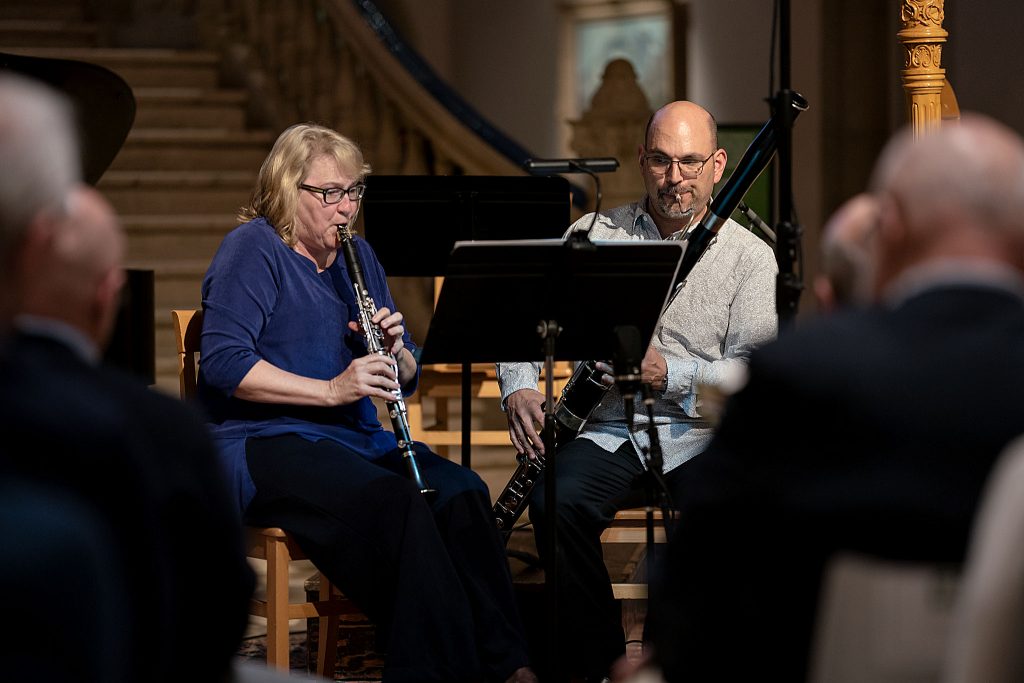Art of Élan: Fine Performance Without Applause–an Idea Whose Time Has Come
Questioning the ritual and protocol of concert attendance is rarely undertaken, but Kate Hatmaker, Artistic and Executive Director of Art of Élan, made a brave suggestion before the group’s concert Tuesday night at the San Diego Museum of Art. She asked the audience seated in the museum atrium—where the concert was presented—not to applaud after each of the seven works on the evening’s program, but to wait until the program was completed to then applaud for all the participants, who would return to the stage at that time.

Terri Tunnicliff & Ryan Simmons [photo (c.) Gary Payne]
Although I am tempted to write another two paragraphs to explain my theory of America’s addiction to applause—how television programming has cultivated this disease—and its Pavlovian intrusion into too many sectors of social life, I will instead do what a critic is supposed to do: write about the music performance.
Following her usual pattern, Hatmaker skillfully mixed music from the Baroque and the early 20th century with works by contemporary composers. Violinist Pei-Chun Tsai, accompanied by Igor Pandurski on piano, gave a wondrously understated, mystical account of Arvo Pärt’s “Spiegel im Spiegel” (“Mirror in a Mirror”). Her bowing was so lithe that it was almost impossible to ascertain exactly when a pitch began, and Pandurski kept the simple, repeating triads of the accompaniment subdued and bell-like.
When clarinetist Terri Tunnicliff launched into the bouncy, devil-may-care Sonata for Clarinet and Bassoon by Francis Poulenc, she not only shattered the mystic silence left by “Spiegel im Spiegel”—there was no audience applause to do the deed—she actually brought the contrast of worldviews between the worldly Parisian sophisticate and the monk-like Estonian into sharp focus. Tunnicliff and bassoonist Ryan Simmons polished Poulenc’s feisty, angular contrapuntal lines with a finesse that wisely retained their saucy wit.
Caroline Shaw’s “Valencia,” a single movement string quartet written in 2010, easily dispelled the usual expectations of thematic exposition and development we associate with the genre. Instead, Shaw fashioned floating ostinatos in the upper strings that hovered gently over contrasting ideas in the cello, some plucked and some bowed. She closely layered her voices together, like the interior segments of an orange—hence her clever title “Valencia.” Like “Spiegel im Spiegel,” Shaw’s work created a tightly focused mood, albeit infused with more urgent expectation than Pärt’s piece reveals. Violinists Pei-Chun Tsai and Igor Pandurski were joined by violist Travis Maril and cellist Abe Liebhaber in Shaw’s “Valencia.”
Carlos Salzedos’ “Scintillation” for solo harp evoked Shaw’s emotional intensity, but with a completely different vocabulary replete with grand melodic flourishes. One of the last century’s most acclaimed harp virtuosos, Salzedo created in 1936 this compact tour de force to exploit his instrument’s wide range of sonic capabilities. I was not at all surprised that Harpist Julie Smith Phillips had memorized this marvelously complex, quickly changing piece. Freed from following the printed score, she was able to completely embrace the demands of her instrument—with spectacular results.
It would be hard to find a more concise, aphoristic musical vocabulary than Hans Werner Henze’s nine miniature movements in his Serenade for cello, played on this program by double bassist Jeremy Kurtz-Harris, unless you pulled down Anton von Webern’s canons from the shelf. Kuzt-Harris dispatched Henze’s crystalline phrases elegantly, using a more pliant timbre than we usually associate with his instrument.
At the piano, Igor Pandurski offered a prelude and postlude to the concert. He opened with François Couperin’s “Les barricades mystérieuses,” a famous harpsichord piece by the French Baroque master that does not easily transfer to the piano, although it is fun to play on the piano. A lighter touch and softer dynamic would have revealed the exquisite linear construction of the piece. For his postlude, he chose Ferruccio Busoni’s transcription of J. S Bach’s chorale prelude “Ich ruf’ zu dir, Herr Jesu Christ,” BWV 639, from his Orgelbüchlein. Busoni’s oft-programmed piano transcription of this organ solo has nothing to do with a Bach sacred cantata based on the same chorale, as the program notes incorrectly suggested.
This concert was presented by Art of Élan at the San Diego Museum of Art on Tuesday, May 7, 2019.

Ken Herman, a classically trained pianist and organist, has covered music for the San Diego Union, the Los Angeles Times’ San Diego Edition, and for sandiego.com. He has won numerous awards, including first place for Live Performance and Opera Reviews in the 2017, the 2018, and the 2019 Excellence in Journalism Awards competition held by the San Diego Press Club. A Chicago native, he came to San Diego to pursue a graduate degree and stayed.Read more…

Have or will you address the recent propensity of U.S. audiences to give a standing ovation at the conclusion of almost every concert?
Worth a mention at the right time. For the record, however, at tonight’s San Diego Opera “One Amazing Night” concert at the Balboa Theatre, although the audience gave the two singers and the orchestra a rousing final ovation, I saw only 2 persons standing on the main floor of the theater.